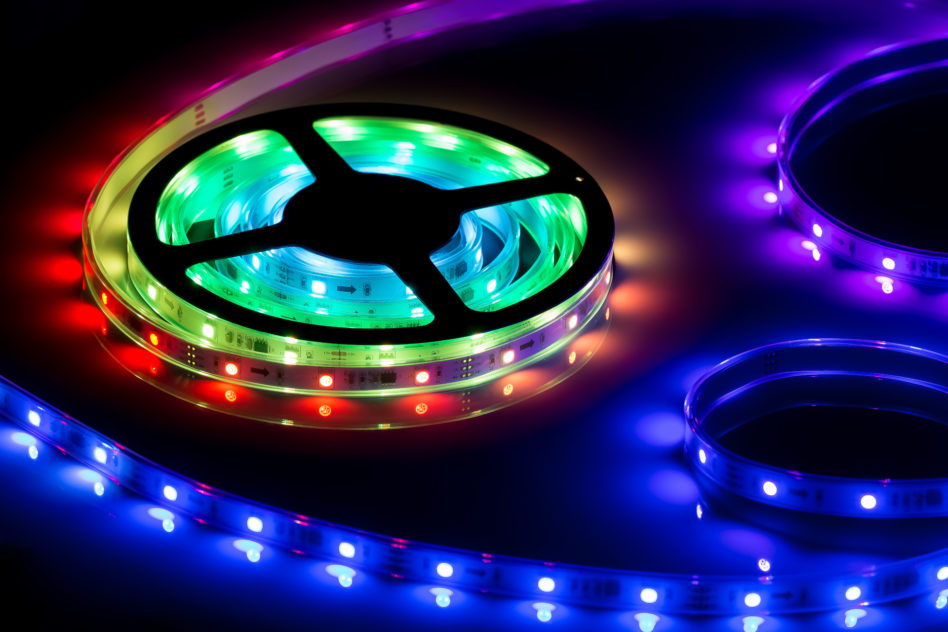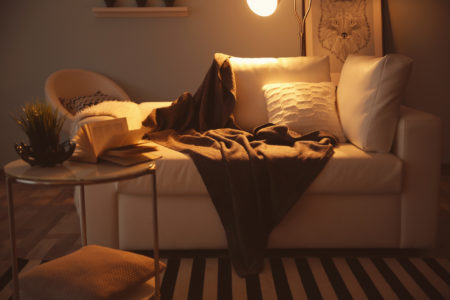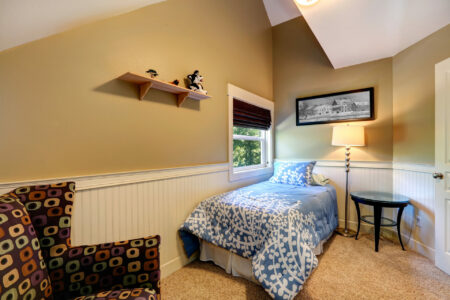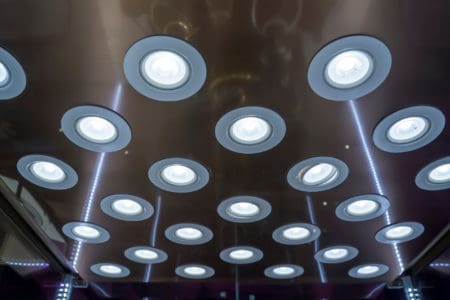LED strip lights are available in many different variations. You can install LED strips with little effort and create a beautiful decorative lighting. With their controllers you can set countless colors and activate great lighting effects. Here you will find an overview of the different LED strips on the market and what you should look for before your purchase.
LED Strip Lighting Guide
LED strips are very popular these days. There are many ideas for decorative lighting or even to illuminate entire rooms and areas. Their popularity mainly comes from their low prices, easy installation and availability in almost any length. The following terms are also often used:
- LED strips
- LED stripe
- LED strip light
- LED adhesive strips
The two terms LED strip or LED strip light are the most common here. The term LED adhesive strip is more colloquial, as most LED strips are self-adhesive. But LED strips should not be confused with an LED bars. Unlike flexible LED strips, LED bars have a rigid construction with a fixed length.
How are LED strips constructed?
Usual LED strip lights consist of a flexible carrier material with integrated copper conductors. The LEDs are placed at intervals and are soldered to the live conductors. In many LED strips SMD light emitting diodes of type SMD5050 are used. These have dimensions of 5.0 x 5.0 mm. Depending on the variant, a series resistor or a current driver is placed next to each LED.
The individual LEDs are electrically combined into segments. Within a segment, the LEDs are connected in series. All segments are then supplied as a parallel circuit. Between the segments are so called cut marks where an LED strip may be separated.
The finished LED strip is coated with a protective lacquer to protect the conductor tracks from corrosion. On the back side there is an adhesive tape, which allows an easy attachment of the LED strip to any surface.
LED strip variations
LED strips are manufactured by the meter and are usually sold as multiples of one meter (3.28ft). For best delivery and transport, the strips are wound up on a roll. The most sold LED strips have a length of 5 meters (16.4ft) and can be shortened to the required length. You can also attach multiple strips if this length is required.
The functional principles of LED strips are always similar but may differ in some details. So different LED chips are used in different placement density. The number of channels determines the color variety. Below you will find an overview of the most common variants of LED strips on the market.
What colors are available?
When entering the market, mainly RGB LED strips were available. The abbreviation RGB stands for the colors red, green and blue. Strictly speaking, each RGB LED consists of three light-emitting diodes of the respective colors. With the usual LED controllers, in theory a total of about 16.7 million colors can be set for an RGB strip by mixing the individual colors.
White light can also be produced by mixing the colors in the appropriate ratio. But due to the limited color spectrum of the RGB LEDs, the achieved white tone appears quite unnatural and the colors of the illuminated environment are distorted. To solve this problem, LED strips with other LED combinations are now available.
| Name | Channels | LEDs | Colors | |
|---|---|---|---|---|
| RGB | 3 | red, green, blue | Multicolor | |
| RGBW | 4 | red, green, blue, white | Multicolor, cool or warm white | |
| RGBWW | 5 | red, green, blue, cool white, warm white | Multicolor, cool to warm white adjustable | |
| White | 1 | white | cool or warm white | |
| Dual White | 2 | cool white, warm white | cool to warm white adjustable |
An RGBW strip has an additional white channel in addition to the three channels for the primary colors. The decision for the color temperature must be made here before the purchase, since this cannot be changed later.
An RGBWW strip has two additional white channels with cool white and warm white LEDs. In addition to bright colors, the color temperature of the white light can also be adjusted at any time.
White (unicolor) strips have a fixed light color that cannot be adjusted. LED strips in dual white, on the other hand, have two white channels. Thus, the color temperature can be adjusted at any time.
The terms RGB and RGBW are mainly used unambiguously. But with RGBWW strips, some manufacturers also understand the LED combination RGB + warm white (4 channels). So you always need to pay attention to the exact product description before buying. Otherwise you could be disappointed later on.
How many watts per foot?
Since LED strips are manufactured and sold by length, their power is also specified in watts per foot. This makes it easy to compare different strip lights with different LED types and spacing. Today there are LED strips with all imaginable LED types available, but these three chips are the most common:
- SMD3528: 3,5 x 2,8 mm, ca. 25mA
- SMD5050: 5,0 x 5,0 mm, ca. 60mA
- SMD5630: 5,6 x 3,0 mm, ca. 150mA
The power rating watts per foot then results from the LED chip used as well as the number of LEDs on the strip. These are some common configurations you can buy in the store or online:
| LED chip | Number | Watts per foot | Lumens per foot | Usage |
|---|---|---|---|---|
| SMD3528 | 18/ft | 1,5 W/ft | 110 lm/ft | decorative lighting |
| SMD5050 | 9/ft | 2,2 W/ft | 150 lm/ft | decorative lighting |
| SMD5050 | 18/ft | 4,4 W/ft | 290 lm/ft | decorative/ambient lighting |
| SMD5050 | 36/ft | 8,7 W/ft | 580 lm/ft | ambient lighting |
| SMD5630 | 18/ft | 7,3 W/ft | 8,20 lm/ft | ambient lighting |
The LED chips listed in the table with 9, 18 or 36 LEDs per foot (30, 60 or 120 LEDs per meter) are installed on many LED strips. But some manufacturers specify the number of LEDs per roll (5m) instead. Here you have to convert the number yourself. The data on power and brightness are only approximate values. These depend largely on the efficiency of the LEDs used on the respective strip.
Bright LED strip lights
In order to achieve the highest possible light output per foot, you can either choose the high density LED strips with at least 36 LEDs per foot. Alternatively, you can choose a strip with high power per LED chip.
12V or 24V?
Most LED strips, especially in the consumer sector, are operated with 12V low voltage. However, there are also variants with 24V operating voltage. These are advantageous especially for larger installations with long cable lengths. Doubling the voltage from 12 to 24V results in only half the current.
This has following advantage: If two LED strips are connected to the same power supply, one with a short feed line of 3ft length and the second strip with a thin feed line of 30ft length, the latter would shine somewhat darker. Also a single LED strip with 16.4ft length or more would get a little darker from the beginning to the end of the strip.
But there is also a small disadvantage: With most 12V strips, 3 LEDs are always connected in series and form a segment where the LED strip can be cut. With 24V strips, on the other hand, a segment consists of 6 LEDs. So the distances where the strip can be cut down are longer.
For larger installations with long cable runs as well as for long LED strips with high power, the 24V technology is advantageous due to their lower voltage drop which ensures a uniform brightness.
Are LED strips dimmable?
Adjusting the brightness of LEDs requires a technically complex dimming process. Since the LED strip itself only contains the LEDs and their series resistor or current driver, LED strips can be dimmed without any problems. So technically the dimming process does not take place on the LED strip but in the transformer or LED controller. With these options LED strip lights can be dimmed:
- Connection to dimmable transformer
- Operation on dimmable LED controller
On the one hand, the LED strip can be operated with a dimmable LED transformer. The transformer can then be connected to a wall dimmer. This solution is mainly used for single-color LED strips, since there are no other adjustment options besides the brightness.
More common is the operation of the LED strip on an LED controller. These usually come with a remote controller, which can be used to dim the LED strip. In addition, the colors can be adjusted or light effects can be activated.
Controllers and remote controls
LED controllers are mainly used to control multicolor LED strips. These are supplied with a power supply and can control the color channels of the LED strip individually. For dual white LED strips, any mixture of warm white and cool white can be activated. With an RGB strip, almost any light color can be set.
With many controllers, numerous light effects can also be activated. Light flashing, color change or fading are the most common effects available. These controllers are usually operated conveniently via a remote control. These are some common remote controls:
- Infrared remote control with 24 buttons
- Infrared remote control with 44 buttons
- Radio remote control
Especially the two infrared remote controls are included in numerous LED strip sets. But infrared only works within sight. If you want to control the LED strip from another room, a remote control with RF technology is the better choice. Alternatively there are also LED controllers with Bluetooth or WiFi available. Here you can control the LED strip via an app on your phone.
How many colors are possible?
Most controllers internally operate with an 8-bit PWM (pulse width modulation). With an RGB strip, 256 brightness levels can be activated per channel. Over all three channels, this results in a total of approx. 16.7 million colors. However, this is a theoretical value, since the characteristic curve is not linear. But in practice almost any light color can be mixed.
LED strip without transformer
The many adjustment options of some LED strips are practical, but in some locations you just want to use a single-color LED strip without a lot of wiring or any remote control. In this scenario a simple LED strip without any transformer or complex controller is very practical.
Since the LEDs on the carrier strip always have to be operated with low voltage, a power supply unit is also necessary here. But there are ready-to-connect 110V LED strips with a wall plug. Here the required transformer is already integrated in the supply line or in the plug. Depending on the model, the strip lights up immediately after plugging in or there is a simple cord switch. So any further wiring efforts can be skipped.
Are LED strips suitable for outdoor use?
If you want to install your LED strip outdoors, the strips must be weather-resistant or even waterproof. Most LED strips are unprotected and therefore only suitable for indoor use. Their carrier material is merely coated with a thin protective varnish to protect the conductor tracks from corrosion. But the soldering joints of the LEDs are exposed. The advantage of these strips is their high flexibility due to the thin strip. They can also be easily extended and shortened.
LED strip lights for outdoor use are encapsulated with a transparent compound (epoxy resin or silicone). But this means that these strips are no longer as flexible and must be bent in a greater radius. When shortening, it should also be noted that the strip is no longer watertight at the cut and must be resealed.
Are there any differences in quality?
As with most LED lights, there are also large differences in quality for LED strips. They often differ in the following characteristics:
- Luminous efficiency
- Lifetime
- Color rendering index
- Conductor thickness
The quality of the LED chips determines the light output and their efficiency. In some cheap strips, the LEDs are operated with an overcurrent so that they shine brighter. However this reduces the life of the LEDs, which can cause them to fail prematurely.
There are also differences in the quality of color rendering. A color rendering index greater than 90 ensures faithful color reproduction. With many cheap strips, the value is usually not even specified. There is another difference in the thickness of the conductor path. If the copper tracks are thinner, there is a voltage drop even with shorter strips which results in a difference in brightness.
How important is the quality?
High quality LED strips are more expensive and can be found mainly at specialized retailers. The extra cost is worth it primarily when the LED strips are used as the only room lighting. As additional decorative lighting, even the cheap LED strips are usually sufficient.
Conclusion
LED strips are ideally suited for effective decorative lighting. But also for the basic lighting LED strip lights can be used quite well. The large number of variations does not make the choice that easy. With this guide you have a good overview of the structure and the differences of the common LED strips. So you can find the right LED strip light for your application.






